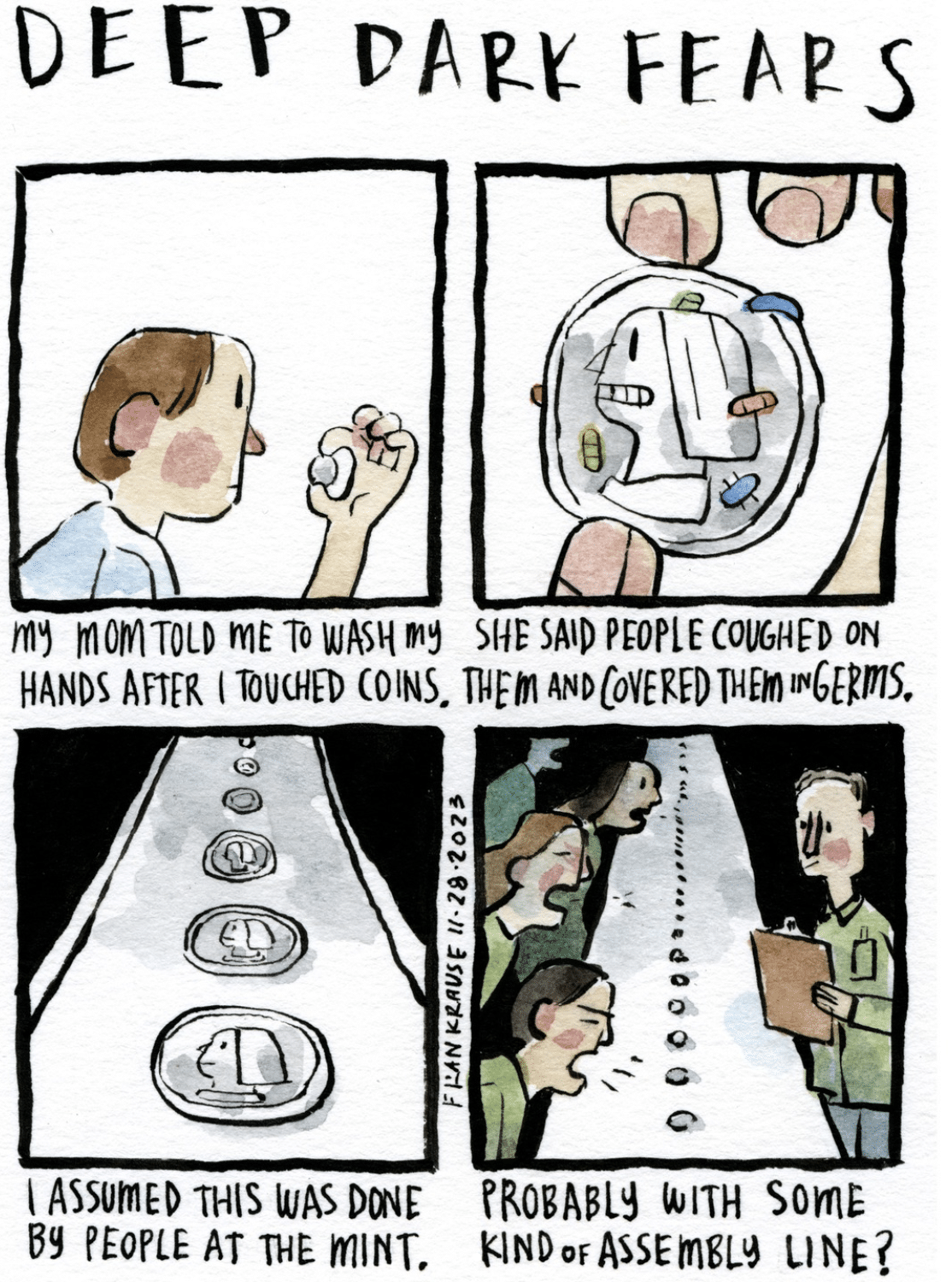“Comics about illness, and disability—both mental and physical—have multiplied hugely over the past twenty years as people have recognized the form’s immediacy and its diagrammatic ability to display otherwise hard-to-express realities and sensations. The capacity of comics to be diagrammatic—representing objects in space and in time, showing and telling—serves the authors of many different kinds of stories.”
-Why Comics by Hillary Chute
Comics has the wonderful ability to seamlessly flow between the imagined or metaphorical and the real. When reading a comic we take it for granted that a nauseous character may not actually be green even though we’re looking at a green-faced sailor. If you read a lot of comics, this might not seem remarkable, but the ability to see something drawn on a page one way and understand that in ‘reality’ it might be another, is really special. This cartoon alchemy lets us portray people’s internal experiences in ways no other medium can.
The quaint but macabre swipe comic Deep Dark Fears by Fran Krause is an excellent example of this singular power. The series follows a simple four panel comic strip format: Panels One through Three are the setup and Panel Four is the punchline. But rather than gags, the setup describes the anxious foundations upon which an irrational fear, revealed in Panel Four, is built.


An installment of Deep Dark Fears from August, 2025
While the fears are all irrational, such as wearing baggy pants all the time leading to walking out your door naked without realizing it or worrying your heart has come loose in your body and is bouncing around on your run, each strip has an undercurrent of very real anxiety. The fears in Deep Dark Fears are never made to seem ridiculous. Instead, they’re secrets revealed, embarrassing phobias unmasked in comics form. The format means that, as long as you’re reading the comic on Instagram rather than Tumblr, you can’t unconsciously skip to the end. Deep Dark Fears must be read as the fears are felt, slowly building in intensity, each panel rationalizing the next until you can’t help but arrive at an inevitable, horrifying conclusion.
Deep Dark Fears harkens back to one of the earliest examples of graphic memoir and mental illness in comics, Justin Greene’s 1972 book Binky Brown Meets the Holy Virgin Mary, a work that reveals its author’s struggle with OCD as a child. In Binky Brown, the protagonist Binky becomes convinced that his extremities emit rays of sin which must be pointed away from depictions of the Virgin Mary at all costs. The story is notable from a comics theory perspective not just for the novelty of its length, form, and subject matter, but also because it exemplifies comics’s ability to portray a person’s internal reality externalized. A contemporary example from the graphic novel medium is Zoe Thorogood’s 2022 book It’s Lonely at the Center of the Earth, in which Thorogood’s various mental states, including her depression become embodied characters interacting as Thorogood moves through the world.
In both works, as with Deep Dark Fears, the reader understands that the characters’ mental realities are not indicative of literal physical reality. Chute notes “Comics can make visible both external features of a condition, and internal, cognitive and emotional features that are otherwise hard to communicate accurately.” While the short nature of Deep Dark Fears strips makes it difficult to classify as a definitive ‘anxiety comic,’ whatever that might be, the strips have an undeniable ability to humanize those anxious fears which often feel so un-empathetic.


An installment of Deep Dark Fears from August, 2025
The series’s water color style which often melds colors and jumps outside of the lines, along with its ink brush linework and lettering style calls attention to the fact that the series is drawn by a very human hand. The way the water color paper is scanned, which highlights the paper stock and fiber rather than tuning them out entirely makes each fear increasingly tangible and empathetic. Unlike other series focusing on anxiety like Alison Bechdel’s Dykes to Watch Out For, Deep Dark Fears isn’t disconcerting, it’s soothing. The art style feels cozy, although often eerie, the endings are never gruesome, and for the subject matter, there is a shocking dearth of horrified, pained, or angry faces.
The series creator solicits submissions of fears from readers on their tumblr, but none of the strips tell you if they’re ‘real’ or made up, but the fact is it doesn’t matter. Much like the distinction between fear and reality is made insignificant by the comics form, so too is the distinction between fiction and nonfiction made irrelevant. Deep Dark Fears acknowledges the fears within each of us as valid and yet, in a sea of anxiety, the series remains a quiet, calming island.


